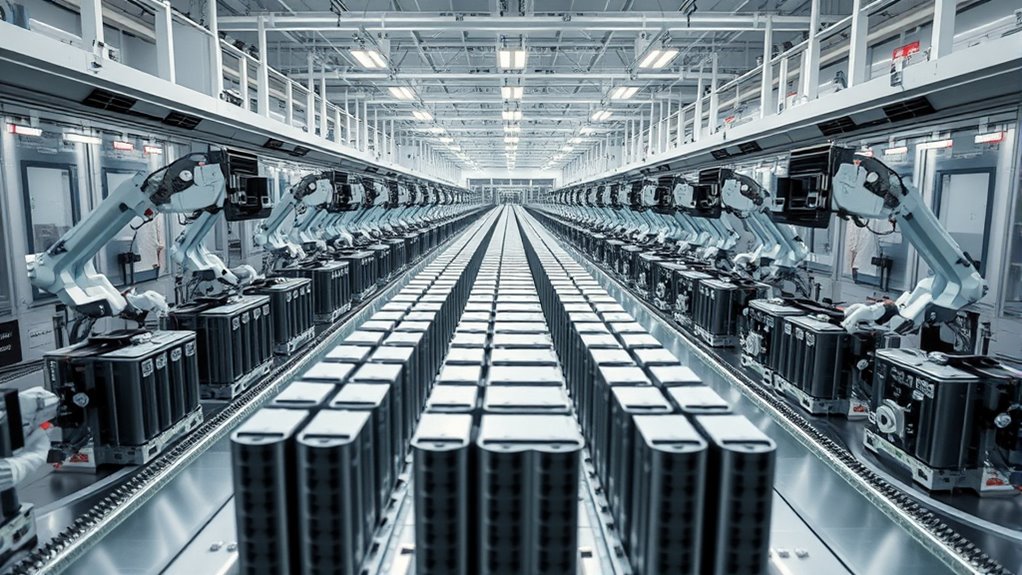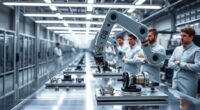Tesla relies on several top battery manufacturers to supply its electric vehicles, including Panasonic, LG Chem, CATL, and Samsung SDI. These companies provide the advanced battery cells that power Tesla’s cars, helping the company improve energy density, safety, and overall performance. Tesla also invests in its own battery technology and manufacturing, like the Gigafactories. If you want to learn how these partnerships shape Tesla’s technology and future plans, keep exploring the details.
Key Takeaways
- Tesla collaborates with several leading battery manufacturers, including Panasonic, LG Chem, and CATL.
- Panasonic has been a primary supplier of batteries for Tesla’s earlier models, especially at the Gigafactory in Nevada.
- Tesla also partners with CATL and LG Chem to supply batteries for various global markets and new vehicle models.
- Tesla invests in vertical integration and owns its battery cell production facilities to supplement external suppliers.
- These partnerships ensure Tesla access to advanced battery chemistries and scalable supply for its electric vehicles.

Tesla’s push to dominate the electric vehicle market depends heavily on its partnerships with leading battery manufacturers. These collaborations are essential because the quality and availability of batteries directly influence Tesla’s ability to deliver high-performance, affordable EVs. When it comes to making these batteries, understanding the nuances of battery chemistry and supply chain logistics becomes critical. You need to know that Tesla invests in advanced battery chemistries to improve energy density, longevity, and safety. Lithium-ion batteries, particularly those with nickel, cobalt, and manganese cathodes, are standard. Tesla’s focus on refining battery chemistry helps them push the boundaries of range and charging speed, giving their vehicles a competitive edge. By working with suppliers who develop cutting-edge chemistries, Tesla guarantees its batteries stay at the forefront of technology, which is indispensable for scaling production and maintaining market leadership.
Supply chain logistics also play a pivotal role. You might not see it at first glance, but securing a reliable, efficient supply chain is what keeps Tesla’s battery production humming. The company sources raw materials like lithium, nickel, and cobalt from various regions around the world, often facing geopolitical and economic challenges. Coordinating the logistics of extracting, processing, and transporting these materials requires meticulous planning. Tesla’s partnerships with mining companies and material processors help streamline this process, reducing delays and costs. They aim to minimize supply chain disruptions by diversifying sources and investing in vertical integration, like their Gigafactories, which manufacture batteries at scale. This approach not only speeds up production but also offers more control over quality and costs.
Furthermore, Tesla’s emphasis on supply chain logistics affects the consistency and sustainability of battery production. You want batteries that perform reliably over time, and that means guaranteeing a steady, ethical supply of raw materials. Tesla actively seeks to reduce reliance on conflict minerals and improve recycling efforts to create a more sustainable supply chain. Their partnerships with battery manufacturers like Panasonic, LG Chem, and CATL reflect their strategy to combine advanced battery chemistry with robust logistics. This synergy helps Tesla meet rising demand while maintaining quality standards and keeping costs in check. Additionally, staying informed about expert advice related to sustainable sourcing and recycling can further optimize Tesla’s supply chain resilience.
In essence, Tesla’s success hinges on the delicate balance between innovative battery chemistry and efficient supply chain logistics. By collaborating with top-tier battery makers, they’re building a resilient, scalable ecosystem that supports their ambitious plans for global EV dominance. This integrated approach ensures Tesla can deliver cutting-edge batteries to their vehicles, fueling their growth and maintaining their competitive edge in the rapidly evolving electric vehicle landscape.
Frequently Asked Questions
Are Tesla Batteries Recyclable?
Yes, Tesla batteries are recyclable. You can participate in battery recycling programs that help recover valuable raw materials like lithium, cobalt, and nickel, reducing environmental impact. Tesla emphasizes sustainable raw material sourcing and designs batteries for easier recycling. By recycling your Tesla battery, you contribute to a circular economy, ensuring these materials are reused efficiently and responsibly, ultimately supporting environmental conservation and resource sustainability.
How Long Do Tesla Batteries Typically Last?
Think of your Tesla battery as a marathon runner—lasting for many years. Typically, it’s designed to last around 8 to 10 years, with some degradation over time. Battery degradation gradually reduces range, but Tesla offers extensive warranty coverage to protect you. Proper care can extend its life, ensuring your electric journey stays smooth. So, your Tesla battery’s longevity depends on usage, but it’s built to endure many miles.
What Innovations Are Upcoming in Tesla Battery Tech?
Tesla’s upcoming battery innovations focus on advanced battery chemistry, aiming to increase energy density and longevity. You can expect improvements like the new tabless cell design and solid-state technology, which will boost performance and safety. Tesla collaborates with manufacturing partners to scale these innovations efficiently, ensuring you get more reliable, longer-lasting batteries. These advancements will make your Tesla more efficient, with faster charging and extended driving range, shaping the future of electric vehicles.
Do Tesla Batteries Contain Rare or Hazardous Materials?
You should know that Tesla batteries do contain some rare and hazardous materials, like cobalt and nickel, which make up about 10-20% of the battery composition. These materials are sourced carefully to reduce environmental impact, but concerns about their sustainability persist. Tesla actively works on material sourcing and recycling to minimize reliance on hazardous materials, aiming for safer, more ethical battery production in the future.
Can Tesla Batteries Be Used for Home Energy Storage?
Yes, you can use Tesla batteries for home energy storage, especially with solar integration. Tesla’s Powerwall offers a reliable way to store excess solar power, helping you reduce reliance on the grid. Its battery capacity is designed to meet typical household needs, providing backup during outages and optimizing energy use. With easy installation and smart management, Tesla batteries make home energy storage practical and efficient for everyday use.
Conclusion
You might be surprised to learn that Tesla’s batteries are primarily made by Panasonic, LG, and CATL. These companies supply over 90% of Tesla’s battery cells, ensuring the company’s dominance in electric vehicle technology. With over 100 gigawatt-hours of batteries produced annually, Tesla is pushing the boundaries of clean energy. This collaboration and scale highlight how Tesla continues to innovate and lead in the EV market, shaping a sustainable future for us all.










